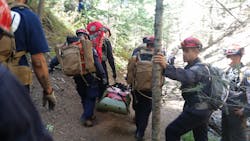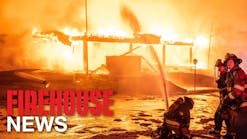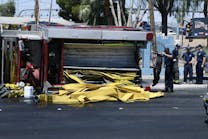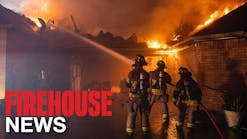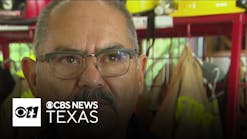Wildland Firefighting: The RIT of Wildland Firefighting
On June 30, 2013, 19 members of the Granite Mountain Hotshots were killed fighting the Yarnell Hill Fire near Prescott, AZ. It was the worst loss of firefighters in the line of duty since the events of Sept. 11, 2001, and nothing has approached it since. In a touching and powerful eulogy, Vice President Joe Biden stated, “All men are created equal, but then a few become firefighters. Thank God for your willingness to take the risk that you do … we all owe you.” While every firefighter accepts the fact that the job involves risk, we also know that nobody—not our leaders, not our partners, and not the communities we serve—wants us to take uncalculated or unnecessary risks.
Dangerous reality
Last year was a busy year for wildland fires. More than 68,000 fires burned more than 10.1 million acres in the United States in 2015. Data from the National Interagency Fire Center clearly demonstrate that wildland fires have become bigger and more costly over the last 10 years. Since 2005, the average number of wildland fires per year has increased by 2.5 percent, and the average number of acres burned per year has increased by 15.6 percent.
At the same time, the number and size of wildland/urban interface (WUI) areas are also growing rapidly. In 2012, the International Association of Wildland Fire reported that there were more than 200 million acres of WUI in the United States, with roughly 2 million acres being converted per year since 1990. The 2012 U.S. Census revealed that there were already more than 46 million homes within the WUI, occupied by 120 million people. The unfortunate consequence is that every year more firefighters are injured or killed responding to wildland and WUI fires, calling for a national initiative to promote safer communities and more effective response strategies.
WUI safety
Experience has shown that the issue of WUI fire safety is one that can only be addressed as a team. Responders to WUI fires often come from multiple agencies, each of which has a specific function and a critical role to play in a coordinated response. Any initiative to address better safety standards will have to be a collaborative effort among those agencies.
The U.S. Forest Service (USFS) is one of our biggest and most influential teammates in this initiative. In advance of the 2016 fire season, USFS Chief Tom Tidwell released his Letter of Intent for the wildland fire season. Chief Tidwell stated, “We commit to co-leadership with our partners to continuously improve the wildland fire system, to more reliably protect responders and the public.” He went on to say that, “during periods [of intense fire behavior] protecting lives of responders is the objective—we don’t expect and we won’t allow responders to risk their lives attempting the improbable.” He concluded, “it is only by working together that we can put life first and ensure that everyone goes home safely every day.”
The intent of this WUI fire safety initiative should not be new to those of us in the response community in the United States. In structural firefighting, we have learned to follow simple risk guidelines—we will risk a lot to save a lot; we will risk nothing to save nothing—and are often relegated to defensive actions and exposure protection when there are no lives to be saved, only property to be lost. The same is true in EMS—we will await clearance by law enforcement when the perception of a dangerous situation exists. Indeed, Chief Tidwell’s invitation is for all the teammates to participate in making sure we respond aggressively, most often with the closest resource, while encouraging our responders to make safety their priority at all times.
It is hard to determine whether the safety of WUI responders is a policy or an operational issue, but likely it is both. There is no question that we should continue to recognize the increased hazards of first response. We should mandate annual physicals and physical ability testing, we should train continuously, we should identify target hazards and adequately mitigate risks, and we should continue to create tools to protect ourselves. This is not only in line with our partner’s intent; it just makes sense.
Rapid Extraction Module
Like the USFS, fire departments are teammates in the push to adequately prepare for and respond to WUI issues. Their innovations—be they policies, procedures or specific tools—can be shared and adopted for the benefit of all of us.
One such tool, called the Rapid Extraction Module (REM), was borne out of necessity in California. The REM, as defined in the Firescope California Incident Command System Position Manual (ICS-223-12), is a team of two responders trained in technical rescue and ropes, with the purpose of affecting a rapid extraction of a downed firefighter, should the need arise. It is the intent of the REM to provide firefighters who are unable to egress under their own power a safe and secure transport off the fireline, while simultaneously giving them appropriate medical attention.
An incident within an incident on the Rough Fire in 2015 is the first known use of an REM for its designed purpose. During this fire, a firefighter who was trapped by a burning log was moved with the assistance of an REM. It was estimated that the use of the specialized team reduced the time of extraction by a factor of three or four. Not only was the extraction accomplished significantly faster but the injured firefighter was also receiving appropriate medical attention the entire time.
Santa Fe’s REM experience
The experience of the Santa Fe Fire Department (SFFD) in creating a REM for use in New Mexico (and beyond) has been much like California’s. SFFD learned about the need for such a resource from experiences on past fires as well as its own community risk assessment.
Using the Firescope Manual as a starting point, the SFFD chose to include four rope technicians, and to ensure that all four are EMTs with at least one trained to the paramedic level. The SFFD REM is required to carry all the equipment needed for advanced life support as well as the equipment needed to affect a low-angle rescue or helicopter hoist. They are equipped with a battery-powered hydraulic extrication tool in case a need for vehicle extrication (or lifting) arises. To prepare for possible missions, training also included work with the New Mexico Army National Guard unit, using their hoist from the Blackhawk helicopters to transport injured patients.
After a year of preparation, the SFFD REM was officially offered as a resource in the beginning of 2016. Approaching the end of June, this resource has been deployed to four fires. SFFD Assistant Chief Jan Snyder reported that some of the reactions when the REM showed up were in the form of questions: “Who are you?” “Who ordered you?” “What’s your mission?” and “How do we pay you?” He acknowledged that these are predictable responses to an unknown and emerging resource, usually mitigated by strong leadership from within the REM.
Fortunately for the SFFD, though unfortunately for the injured firefighter, an incident early on provided a perfect opportunity to demonstrate the value of the REM as a resource. Shortly after demobilization from their first deployment, a firefighter experienced an injury that prevented him from being removed from the fireline in a safe and efficient manner. With the REM unavailable, conventional wildland fire EMS support and fire resources took approximately 8 hours to move him to a site where he could be transported to proper medical care. Deployment of the REM might have reduced the time it took to remove the injured firefighter to 2 or 3 hours, while delivering appropriate medical care to him along the way. Since then, requests for the REM have come in, one after the other, and the value of it as a resource is widely recognized and shared.
Future of the REM
It is likely that many larger departments already have the capability to address firefighter safety through the creation and deployment of Rapid Extraction Modules. An REM is much like a rapid-intervention team used by mandate at all structural fire operations. While the concept is not new to the profession, the application in a wildland fire situation is new. Many (if not most) fire departments can support the REM mission, if and when it is properly identified as a national resource, and individuals/teams can be vetted through the nationwide red card system to ensure proper capabilities.
The future deployment of the REM in wildland and WUI incidents is uncertain. For the SFFD, our REM’s first season as a deployable asset has to be considered a success: The team has improved firefighter safety on numerous wildland fires and strengthened rescue capabilities in many cases. There is still work to be done with local and national wildland fire leaders to formalize the use of REM, including official resource typing, creating a deployment matrix to outline when and where an REM is appropriate, and continuing resource capability education for all the stakeholders.
What is clear is that it takes all of us, working together, to ensure that everyone goes home safe. A REM could not have prevented the deaths of the 19 Hotshots from the Prescott Fire Department, but the kind of innovation that led to the creation of the REM just might develop a tool that could do that in the future.
We must all continue to strive to respond safely and with a greater awareness of the risks that we might encounter. In recognition of Chief Tidwell’s comments, with the creation and use of resources such as Rapid Extraction Modules, we can all strive to put life first.
Sidebar: SFFD REM Equipment List
- Gear packs (4)
- Life safety rescue rope, with harnesses, webbing and hardware (2)
- Stokes basket with backboard and wheel
- Sked with helicopter tagline kit
- Rope rescue PPE, including goggles for helicopter operations, extra for victim
- Wildland fire PPE, including fire shelters, extra for victim
- VHF programmable portable radios, with chest harnesses (2)
- GPS and handheld weather station
- ALS pack(s), including ALS drugs, AED and LifePak15
- Chainsaw, with tool and chaps kit
- Battery-powered hydraulic extrication tool, with carrying pack
- Pickup trucks (2)
- UTV and trailer
- Misc. rescue, deployment and camping gear
- o Light sticks
- o Flagging
- o AA batteries
- o Tents
- o Sleeping bags
- o Team leader bag
- o Personal items
Erik Litzenberg
Erik Litzenberg is the fire chief for the Santa Fe, NM, Fire Department. He holds a master’s degree in public administration and is currently working on a doctorate in sports administration. Litzenberg is a graduate of the National Fire Academy Executive Fire Officer Program and the Center for Homeland Defense and Security Executive Leadership Program. He represents the IAFC as the chair of the Wildland Fire Policy Committee, and is a member of the Wildland Fire Leadership Council.
